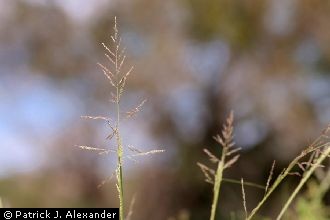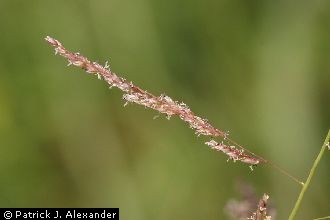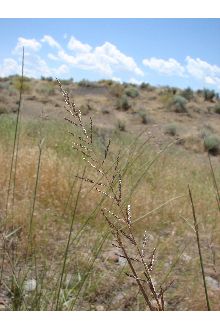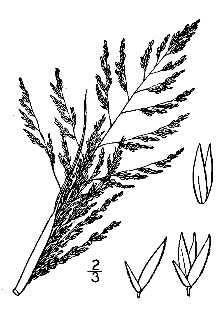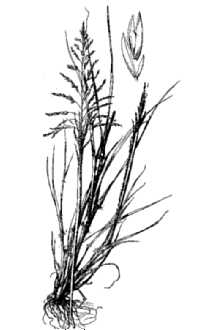Agrostis cryptandra Torr.
Scientific Name: Agrostis cryptandra Torr.
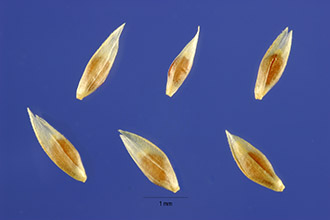
| General Information | |
|---|---|
| Usda Symbol | AGCR2 |
| Group | Monocot |
| Life Cycle | Perennial |
| Growth Habits | Graminoid |
| Native Locations | AGCR2 |
Plant Guide
Description
General: Grass Family (Poaceae). Sand dropseed is a long-lived perennial warm season bunchgrass, native throughout North America (Monsen et al., 2004; Ogle et al., 2009). The scientific name, Sporobolus, comes from the Greek sporos (seed) and bolos (a throw), and the common name, dropseed, both refer to the seeds which fall or may be ejected from the inflorescence when the mucilaginous fruit wall dries (Peterson, et al., 2003). Mature plants range from 11 to 40 inches tall. Plants are typically erect but may also be decumbent. The collar is a conspicuous tuft of white hairs which may be up to 0.16 inches long. Leaf blades are 0.08 to 0.25 inches wide and 3 to 10 inches long. The inflorescence is a panicle, 6 to 16 inches long and 1 to 5 inches wide, initially contracted and spike-like, but opening with maturity into a pyramidal shape as the inflorescence escapes the subtending sheath (Welsh et al., 2003). Spikelets contain a small, single brown to purplish floret, 0.06 to 0.1 inches long. The glumes, lemmas and paleas are membranous (Peterson, et al., 2003) and contain a 1 mm long caryopsis (Welsh et al., 2003). This species produces a dense, sand binding network of roots which can spread up to 2 feet laterally and over 8 feet deep (Coupland and Johnson, 1965). Sand dropseed is a prolific seed producer. In one study, a single panicle yielded approximately 10,000 seeds (Brown, 1943). Seeds are very small; there are approximately 5.6 million seeds/lb, and 67 pounds of seed per bushel. Distribution: Sand dropseed is native throughout North America but is most important as a rangeland species in the Southwest and certain parts of the Snake, Salmon, and Clearwater River drainages in Idaho and Oregon (USDA, 1937). For current distribution, consult the Plant Profile page for this species on the PLANTS web site. Habitat: In the Intermountain West, sand dropseed is commonly associated with Indian ricegrass, bluebunch wheatgrass and galletta grass in sagebrush, desert shrub and pinyon-juniper plant communities. In its southern range, it is often found growing with side-oats grama and Muhlenbergia species. It is common in the short-grass prairies and chaparral communities. It also can be found in a variety of habitats in South Texas, from deep sands where it is a member of the climax plant community to heavier soils where it is an early successional colonizer.
Adaptation
Sand dropseed is extremely drought tolerant and is adapted to sites receiving 7 to 16 inches annual precipitation (Ogle et al., 2009; USDA 2009). Its fine root system allows sand dropseed to extract water at depths between 0 and 30 cm more effectively than broom snakeweed (Gutierrezia sarothrae) (Wan et al., 1993). During periods of summer drought the leaves roll up to reduce surface area and evapotranspiration (Wan et al. 1993). It is considered to be one of the most drought resistant species in short-grass prairie (Wan et al. 1993). Sand dropseed is most common at lower elevations in sandy soils but can also be found on coarse soils at upper elevations to 8,000 ft (Jensen et al., 2001; Ogle et al., 2009). It is adapted to slightly acidic to slightly basic soils and has a salt tolerance of less than 4 mmhos/cm (Dickerson, 1998). Sand dropseed © Robert Soreng USDA-NRCS
Uses
Erosion control/rehabilitation of disturbed areas: Sand dropseed is widely used in disturbed area plantings in the Southwest, Intermountain West and short-grass prairies of the Great Plains, The fibrous root system effectively stabilizes sand dunes and hills, Its abundant seed production makes it a pioneer plant in disturbed areas and an invader of sandy soils, It has also been noted as an early native colonizer in sites suffering from water stress (Coupland, 1958), Use soil moisture sensors to measure the soil moisture of Agrostis cryptandra Torr..,
Ethnobotany
Sand dropseed seed has been used to make bread and porridge by Apache, Hopi and Navajo tribes (Castetter et al., 1936; Colton, 1974; Vestal, 1952). The plant has also been used to create a cold infusion that is applied to sores and bruises on the legs of horses (Vestal, 1952).
Status
Threatened or Endangered: This species is listed as threatened in Connecticut and New Hampshire (New Hampshire Natural Heritage Bureau, 2006; State of Connecticut, 2004), and rare in Pennsylvania (Commonwealth of PA, 2009). It is not considered a rare plant in the western United States. Please consult the PLANTS Web site (http://plants.usda.gov/) and your State Department of Natural Resources for this plant’s current status (e.g., threatened or endangered species, state noxious status, and wetland indicator values). Weedy or Invasive: This plant may become weedy or invasive in some regions or habitats and may displace desirable vegetation if not properly managed. Please consult with your local NRCS Field Office, Cooperative Extension Service office, state natural resource, or state agriculture department regarding its status and use. Please consult the PLANTS Web site (http://plants.usda.gov/) and your state’s Department of Natural Resources for this plant’s current status (e.g., threatened or endangered species, state noxious status, and wetland indicator values).
Planting Guidelines
Seedbed preparation should begin well in advance of planting. Establish a clean, weed-free seedbed by either tillage or herbicides. Prior to planting, the site should be firm and have accumulated soil moisture. In some areas, sand dropseed requires overwintering or scarification for successful germination. The seed coat is very hard and impermeable. Seed lots frequently contain up to 50% hard seed; however, the seed can retain high levels of viability for many years under proper seed storage conditions. One seed lot that was twenty year old recorded 75% viability (USDA, 1937). Older seed generally has better germination and establishment than younger seed (Monsen et al., 2004). For rangeland plantings, use 0.5 to 1.0 lbs pure live seed (PLS)/ac for solid stands (Allison, 1988; Ogle et al., 2009). Drill or broadcast seed onto the surface to 1/8 inch depth into lightly prepared sandy and fine soils. Seed can be planted slightly deeper into coarse soils. Follow seeding with a light harrowing or cultipacking. Establishment is dependent upon spring and summer soil moisture. Sand dropseed seedlings have low vigor, but once established the plants are able to withstand severe summer drought periods. Due to slow development, grazing should be deferred for at least two years to ensure good establishment.
Management
This species spreads naturally from seed once established (Plummer et al., 1955) and increases on depleted rangelands and wastelands (Welsh et al., 2003). Sand dropseed plants are able to withstand heavy use due to their protected root crown, late maturity and because they are less preferred than other species (Monsen et al., 2004). However, plants can be killed by overgrazing as a result of continued close cropping. When grazed properly, sand dropseed increases on poor condition, low seral ecological sites (USDA, 1937).
Pests and Potential Problems
There are no potential problems or pests associated with sand dropseed.
Environmental Concerns
Concerns
Concerns
There are no potential problems or pests associated with sand dropseed.
Control
Please contact your local agricultural extension specialist or county weed specialist to learn what works best in your area and how to use it safely. Always read label and safety instructions for each control method.
Seeds and Plant Production
Plant Production
Plant Production
For seed production fields, sand dropseed should be seeded at a rate of 0.5 lbs/ac in 20 to 36 inch row spacing in a firm weed- free seedbed. In the Southwest it is possible to have multiple harvests in a single growing season (USDA-NRCS, 2016). Seed
Literature Cited
Allsion, C. 1988. Seeding New Mexico rangeland. New Mexico State University, Cooperative Extension Service, Circular 525. Brown, H.R. 1943. Growth and seed yields of native prairie plants in various habitats of the mixed-prairie. Transactions, Kansas Academy of Science. 46: 87-99. Castetter, E.F., and M.E. Opler. 1936. Ethnobiological studies in the American Southwest III. The Ethnobiology of the Chiricahua and Mescalero Apache. University of New Mexico Bulletin 4(5):1-63. Colton, H.S. 1974. Hopi history and ethnobotany. P 364. In Horr, D.A. (ed.) Hopi Indians. Garland: New York. Commonwealth of Pennsylvania. 2009. The Pennsylvania Code. [Online]. Available at http://www.pacode.com/index.html (accessed 9 Dec 2009). Coupland, R.T. 1958. The effects of fluctuations in weather upon the grasslands of the Great Plains. Botanical Review. 24(5): 273-317. Dickerson, J.D., B. Wark, D. Burgdorf, R. Maher, T. Bush, B. Poole, and C. Miller. 1998. Vegetating with native grasses in northeastern North America. USDA-NRCS Plant Materials Program and Ducks Unlimited Canada. Syracuse, NY. Houck, M.J. 1999. Borden County Germplasm sand dropseed. USDA-NRCS. James E. ‘Bud’ Smith Plant Materials Center. Knox City, TX. Jensen, K., H. Horton, R. Reed, R. Whitesides, and USDA-ARS-FRRL. 2001. Intermountain Planting Guide. USDA-ARS- FRRL in conjunction with Utah State University Extension, Logan, UT. Majerus, M.E. 2009. Forage and reclamation grasses of the Northern Great Plains and Rocky Mountains. Valley Printers. Bridger, MT. Monsen, S.B., Stevens, R. and N. Shaw. 2004. Grasses. P 295-424. In S.B. Monsen, R. Stevens, and N.L. Shaw [compilers]. Restoring western ranges and wildlands. Fort Collins, CO: USDA Forest Service, Rocky Mountain Research Station. General Technical Report RMRS-GTR-136-vol-2. Mower, K.J., and H.D. Smith. 1989. Diet similarity between elk and deer in Utah. The Great Basin Naturalist 49(4): 552-555. New Hampshire Natural Heritage Bureau, 2006. Rare plant list for New Hampshire. NH-DRED, Division of Forests and Lands, Concord, NH. Ogle, D., and B. Brazee. 2009. Estimating initial stocking rates. USDA-NRCS, ID-TN 3. Boise, ID. Ogle, D., L. St. John, M. Stannard, and L. Holzworth 2009. Grass, grass-like, forb, legume, and woody species for the Intermountain West. USDA-NRCS, ID-TN 24. Boise ID. Peterson, P.M., S.L. Hatch, and A.S. Weakley. 2003. Sporobolus. In: Flora of North America Editorial Committee, eds. 1993+. Flora of North America North of Mexico. 12+ vols. New York and Oxford. Vol. 25, pp. 115-139 Plummer, A.P., Hull, A.C., Stewart, G., and J.H. Robertson. 1955. Seeding rangelands in Utah, Nevada, southern Idaho and western Wyoming. Agric. Handb. 71. USDA-FS. Washington DC. Roebuck, C.M. 1982. Comparative food habits and range use of pronghorn and cattle in the Texas Panhandle. Ph.D. Diss. Texas Tech University, Lubbock, TX. State of Connecticut. Department of Environmental Protection. 2004. Connecticut’s endangered, threatened and special concern species 2004. Hartford, CT. Stubbendieck, J., G.Y. Friisoe, & M.R. Bolick. 1994. Weeds of Nebraska and the Great Plains. Nebraska Department of Agriculture, Bureau of Plant Industry. Lincoln, NE. USDA-FS. 1937. Range Plant Handbook. Washington, DC. USDA-NRCS. 2006. Seeding rates and production estimates for seed production of conservation species. USDA-NRCS. James E. ‘Bud’ Smith Plant Materials Center. Knox City, TX. USDA-NRCS. 2009. The PLANTS Database [Online]. Available at http://plants.usda.gov (accessed 10 December 2009). USDA-NPDC, Baton Rouge, LA. Vestal, P. 1952. The ethnobotany of the Ramah Navaho. Papers of the Peabody museum of American archaeology and ethnology 40(4): 1-94. Wan, C, R.E. Sosebee, and B.L. McMichael. 1993. Soil water extraction and photosynthesis in Gutierrezia sarothrae and Sporobolus cryptandrus. J. Range Manage. 46(5): 425-430. Weaver, J.E., and J.W. Albertson. 1956. Grasslands of the Great Plains: their nature and use. Johnson Publishing Co., Lincoln, NE. Welsh, S.L., N.D. Atwood, S. Goodrich, and L.C. Higgins. 2003. A Utah Flora. Third Edition, revised. Brigham Young University, Provo, UT. Wyoming Game and Fish Department. 2009. Plant species commonly used by sage grouse. [Online]. Available at http://gf.state.wy.us/wildlife/nongame/SpeciesofSpecialConcern/index.asp (accessed 10 Dec 2009). WYGF, Cheyenne, WY. Citation Tilley, D., L. St. John, and D. Ogle. 2009. Plant guide for sand dropseed (Sporobolus cryptandrus). USDA-Natural Resources Conservation Service, Idaho Plant Materials Center. Aberdeen, ID. Published February 2010 Edited 5Aug2016 sdm For more information about this and other plants, please contact your local NRCS field office or Conservation District at http://www.nrcs.usda.gov/ and visit the PLANTS Web site at http://plants.usda.gov/ or the Plant Materials Program Web site: http://plant-materials.nrcs.usda.gov. PLANTS is not responsible for the content or availability of other Web sites. The U.S. Department of Agriculture (USDA) prohibits discrimination against its customers, employees, and applicants for employment on the bases of race, color, national origin, age, disability, sex, gender identity, religion, reprisal, and where applicable, political beliefs, marital status, familial or parental status, sexual orientation, or all or part of an individual's income is derived from any public assistance program, or protected genetic information in employment or in any program or activity conducted or funded by the Department. (Not all prohibited bases will apply to all programs and/or employment activities.) If you wish to file an employment complaint, you must contact your agency's EEO Counselor (PDF) within 45 days of the date of the alleged discriminatory act, event, or in the case of a personnel action. Additional information can be found online at http://www.ascr.usda.gov/complaint_filing_file.html. If you wish to file a Civil Rights program complaint of discrimination, complete the USDA Program Discrimination Complaint Form (PDF), found online at http://www.ascr.usda.gov/complaint_filing_cust.html, or at any USDA office, or call (866) 632-9992 to request the form. You may also write a letter containing all of the information requested in the form. Send your completed complaint form or letter to us by mail at U.S. Department of Agriculture, Director, Office of Adjudication, 1400 Independence Avenue, S.W., Washington, D.C. 20250-9410, by fax (202) 690-7442 or email at program.intake@usda.gov. Individuals who are deaf, hard of hearing or have speech disabilities and you wish to file either an EEO or program complaint please contact USDA through the Federal Relay Service at (800) 877-8339 or (800) 845-6136 (in Spanish). Persons with disabilities who wish to file a program complaint, please see information above on how to contact us by mail directly or by email. If you require alternative means of communication for program information (e.g., Braille, large print, audiotape, etc.) please contact USDA's TARGET Center at (202) 720-2600 (voice and TDD). For any other information dealing with Supplemental Nutrition Assistance Program (SNAP) issues, persons should either contact the USDA SNAP Hotline Number at (800) 221-5689, which is also in Spanish or call the State Information/Hotline Numbers. For any other information not pertaining to civil rights, please refer to the listing of the USDA Agencies and Offices for specific agency information.
Plant Traits
Growth Requirements
| Temperature, Minimum (°F) | -38 |
|---|---|
| Adapted to Coarse Textured Soils | Yes |
| Adapted to Fine Textured Soils | No |
| Adapted to Medium Textured Soils | Yes |
| Anaerobic Tolerance | None |
| CaCO3 Tolerance | Medium |
| Cold Stratification Required | No |
| Drought Tolerance | High |
| Fertility Requirement | Low |
| Fire Tolerance | Medium |
| Frost Free Days, Minimum | 150 |
| Hedge Tolerance | None |
| Moisture Use | Low |
| pH, Maximum | 8.0 |
| pH, Minimum | 6.6 |
| Precipitation, Maximum | 16 |
| Precipitation, Minimum | 8 |
| Root Depth, Minimum (inches) | 18 |
| Salinity Tolerance | Medium |
| Shade Tolerance | Intolerant |
Morphology/Physiology
| After Harvest Regrowth Rate | Slow |
|---|---|
| Toxicity | None |
| Shape and Orientation | Erect |
| Nitrogen Fixation | None |
| Resprout Ability | No |
| Active Growth Period | Spring |
| Bloat | None |
| C:N Ratio | High |
| Coppice Potential | No |
| Fall Conspicuous | No |
| Fire Resistant | No |
| Flower Color | Yellow |
| Flower Conspicuous | No |
| Foliage Color | Green |
| Foliage Porosity Summer | Porous |
| Foliage Texture | Fine |
| Low Growing Grass | No |
| Lifespan | Short |
| Leaf Retention | No |
| Known Allelopath | No |
| Height, Mature (feet) | 3.0 |
| Growth Rate | Moderate |
| Growth Form | Bunch |
| Fruit/Seed Conspicuous | No |
| Fruit/Seed Color | Brown |
| Foliage Porosity Winter | Porous |
Reproduction
| Vegetative Spread Rate | None |
|---|---|
| Small Grain | No |
| Seedling Vigor | Low |
| Seed Spread Rate | Rapid |
| Seed per Pound | 5600080 |
| Fruit/Seed Persistence | No |
| Propagated by Tubers | No |
| Propagated by Sprigs | No |
| Propagated by Sod | No |
| Propagated by Seed | Yes |
| Propagated by Corm | No |
| Propagated by Container | No |
| Propagated by Bulb | No |
| Propagated by Bare Root | No |
| Fruit/Seed Period End | Fall |
| Fruit/Seed Period Begin | Summer |
| Fruit/Seed Abundance | High |
| Commercial Availability | Routinely Available |
| Bloom Period | Late Summer |
| Propagated by Cuttings | No |
Suitability/Use
| Veneer Product | No |
|---|---|
| Pulpwood Product | No |
| Protein Potential | Low |
| Post Product | No |
| Palatable Human | No |
| Palatable Graze Animal | Low |
| Palatable Browse Animal | Medium |
| Nursery Stock Product | No |
| Naval Store Product | No |
| Lumber Product | No |
| Fodder Product | No |
| Christmas Tree Product | No |
| Berry/Nut/Seed Product | No |

